Pond construction is the most important part of the pond ownership experience. We’ll tell you everything you need to know about building a backyard fish pond that you’ll love and enjoy. Although it can be daunting to start, starting a fish farm can be rewarding, fun, and pay off in the long run when you don’t have much money to spend on food. It can also be a good source of income if you have other people who need extra food. It will also give basic information about how to build a fish pond.
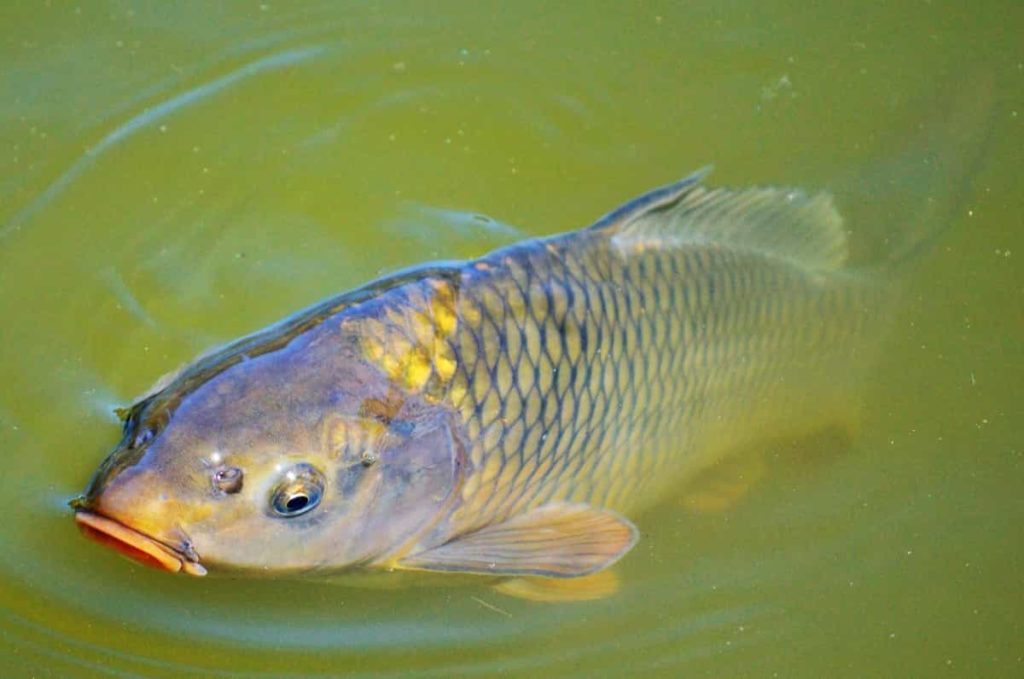
How to build a Fish pond for Beginners
How do you build a simple fish pond?
Decide which fish to farm – Before you start working on your fish farm location, there are some important things you need to consider first—the type of fish you want to raise. As the fish matures, its size may increase. You want to ensure the pond size can handle the type of fish you will raise. You don’t want to grow fish that are too big for your pond size only to find that you are running out of room.
Choose the right location – When you build a fish farm in your backyard or on your property, it needs to be located in the right place to ensure optimal growth and health of the fish. Below are the things to remember when looking for a suitable location:
- The ground surface should be low and level.
- The pond should be placed where it can easily collect or drain natural rainwater. It helps to keep the water fresh and prevent it from becoming stale which can harm the health of your fish.
- You don’t want to place your fish farm near your home because it’s a drowning hazard for small children.
- If the area is subject to extreme heat or cold, you will want to make sure that the area you are going to dig is dug between 8-12 feet to ensure that these extreme temperature changes are not affected. Fish can find plenty of shelter during this time. A tree-shaded pond is also ideal, but you risk digging into large root systems.
What equipment do I need for a fish pond?
Ponds without fish don’t require any equipment unless you want a waterfall or fountain, in which case you’ll need a pump and possibly a few other items, especially if green water becomes a problem. Fish keepers need more than that, not only to keep the pond attractive but to promote the health of their charges. Filters and pumps play an important role in keeping your pool clean and healthy. Now that you have decided on your pool size, type, and what you want to put in your pool, it will be easier to choose the right pool equipment.
There is no one-size-fits-all when it comes to purchasing a pool filter. Finding the best for your pond is often situational and will vary greatly depending on your pond’s type, size, and stock. Please take a look at our pond filter guide to find the right filter for you and your pond. Pond pumps help keep the pond water clean and healthy by oxygenating it with constant movement.
How deep should be a fish pond?
- Four feet of water prevent excess water evaporation and predators from eating the fish. Steep, difficult-to-climb banks will also deter predators. In warm climates where the pond will not freeze, 4 feet is sufficient. A depth of 7 to 8 feet is preferred in temperate climates with mild to cold winters.
- Although building your fish pond can seem daunting, research and planning will help avoid mistakes.
- Any fish is beautiful, although delicate and requires extensive care. Goldfish are not as beautiful, but they are more caring. However, both require a certain size pond to thrive.
The pond should;
- Be larger than 300 m2 to produce fish for food and cash
- Have a square or rectangular shape
- Be shallow with a water depth of 60 cm (upper end) to 90 cm (lower end)
In case you missed it: 22 Key Rules for Effective Fish Farm Management: From Planning to Reducing Production Cost
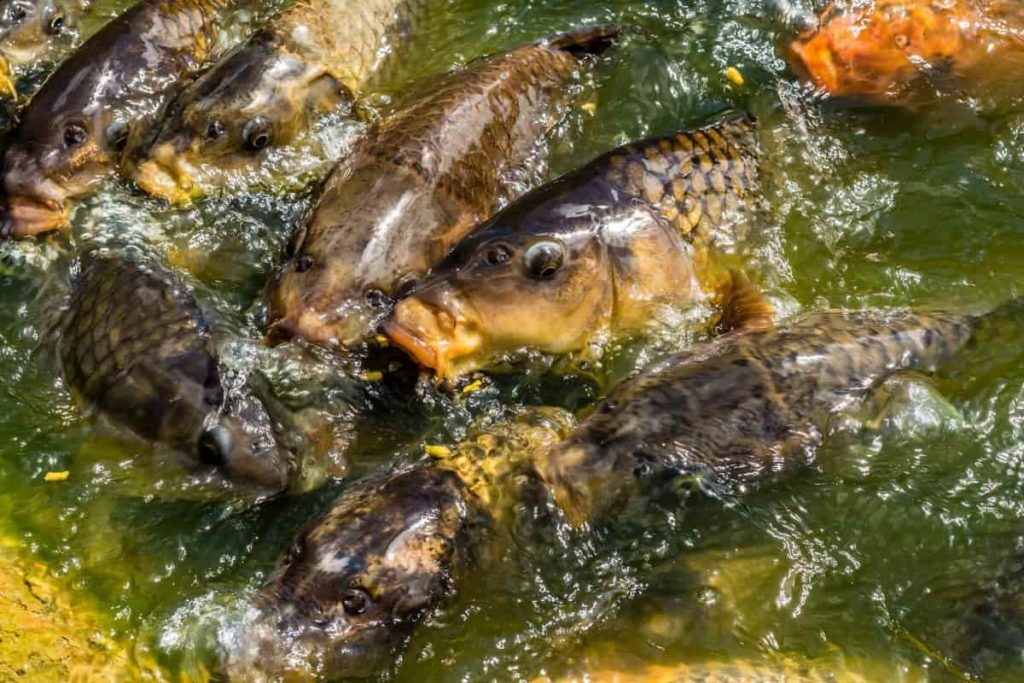
How do you build a backyard fish pond?
Step 1: Mark the area – After deciding where to place your pond in your backyard or garden, use any equipment to help you visualize the shape of your pond and outline your pond. If you’re building an ecological pond rather than a simple water garden, make sure it’s large – a place for fish to live. Outline your desired pond and waterfall with marking paint. Make sure your pool curves are wide.
Step 2: Digging the Pond Area – Finally, it’s time for some hard garden work. Start digging about 6-8 inches deep, then use the dirt to build a plant shelf and a retaining wall. Once you have dug out your pond area, mark another outline about 2 feet deep into your pond. The area you’ve outlined will be full of rocks, so the same thing as when you first outlined your pond: broad curves—the last area to dig in for the skimmer box.
Step 3: Choose a liner – Rigid and flexible pond liners are available for your pond. A prefabricated, rigid pond liner provides a shelf for plants. You can dig the hole in a way that creates a shelf for the plants, giving it a more natural look in your yard.
Step 4: Skimmer and pump – Pack down and level the soil before installing the skimmer. Next, place the tubing and check valve assembly into the skimmer through the grommet and pump. Third, connect the hoses and check the valve together. Finally, attach the overflow pipe to the back of the skimmer while ensuring the overflow hole is above the water level. Once this is set, attach a leak-proof bulkhead to the overflow hole and use a male adapter to connect your tubing to the drainage ditch.
Step 5: Install a filter and consider aeration – Purchase a filter and pump to keep the pool water flowing. The filtration system keeps the water flowing and clean. Depending on the pond’s water volume, you will need a specific size filter. Biological filters are also available. The breeze aerates a large pond; you can replicate this by adding a waterfall or fountain to your small backyard pond.
Step 6: Underlayment and Liner – Underlayment is a thin cushioning layer that can provide insulation against heat and moisture. Apply the bottom layer, starting in the middle and making sure you go all the way to the corners of your pond excavation. Lay the liner in the same way after the underlayment.
Do ponds need pumps?
- In most cases, you can’t have a backyard pond without a pump. You will need a pump to keep your pool water flowing, properly oxygenated, and free of algae and unwanted bacteria. Pumps are especially important in ponds that contain other fish such as Goldfish and Koi.
- Pond pumps are used to aerate and oxygenate the water inside the pond. They work by continuously pushing water through a pump and forcing it into the rest of the pool.
How can I oxygenate my pond quickly?
Oxygen is important in keeping pond water healthy; it occurs naturally but can be depleted quickly, especially in warm weather when fish can be seen gasping for air at the surface.
1. Add a pool air pump – A very simple way to add oxygen to a pond is to add an air pump. Sitting on the pool’s edge, it will pump air through a small hose to the air stone, and the bubbles will enter the water. Oxygen will be added when the bubbles break the surface of the water. Another feature of a pool air pump is that it will act as an anti-ice in the winter; this action will prevent the pool from freezing completely and, leaving a small opening for gases to escape, will remain empty.
Make sure you buy the right pump; some are designed to sit outside in all weather, and others need to be indoors or in a shed to protect from the elements. Larger models pump more air, more air stones and lines can be added, and these models are naturally suited to larger pond systems.
In case you missed it: How to Start Fish Farming on Terrace at Home: in Tanks on Small Scale, and a Guide for Rooftop Fish Farming
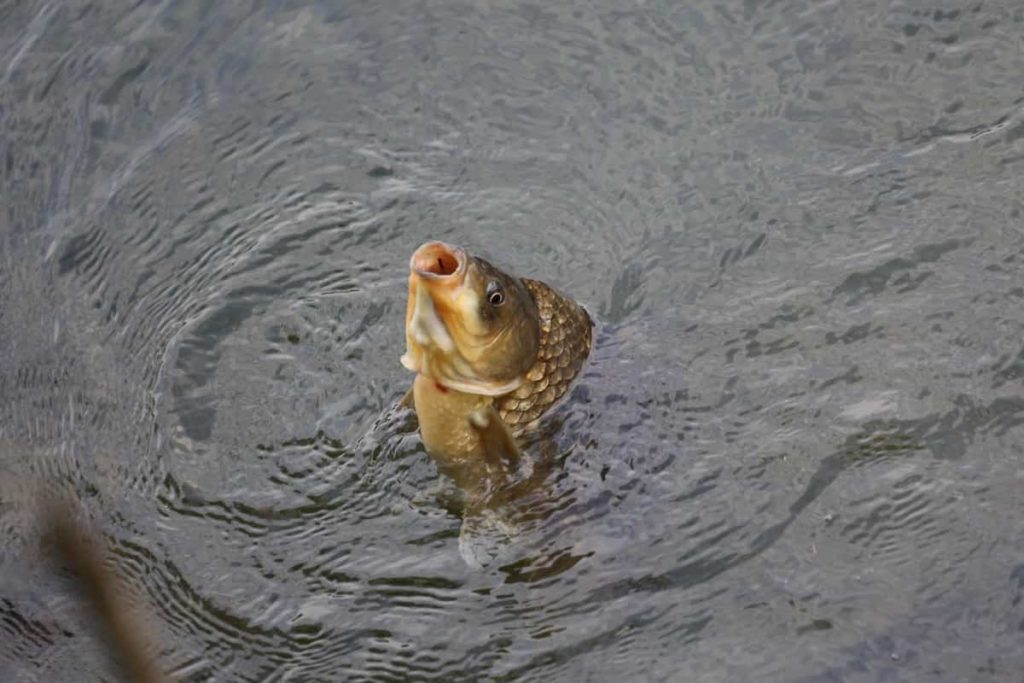
2. You can also introduce a fountain, which means the water constantly breaks the surface while adding oxygen. As a bonus, it’s a very inexpensive way to make your pond an attractive water feature. You don’t want a feature that splashes water out of the pool; however, it may not make an impact if the feature is too small. So be sure to look at the width and height that the fountain pump can achieve.
3. Spray water with your hose – If you don’t have an air pump or fountain, don’t want to buy them, or have an emergency, the best and easiest way to put oxygen back into the pool is to spray water with a hose.
What is the best way to keep pond water clean?
- Your pond is overpopulated if you have more than 10 inches of fish for every 100 gallons of water. Excessive fish waste can create an imbalance in pond water.
- Do not overfeed your fish – When you feed fish more than they can eat, the uneaten food is left to rot in the pond.
- Select a quality fish food – preferably one that will float as opposed to sink to the bottom of the pond if left uneaten.
- Clean debris from the pond before it has a chance to decompose. Your pond skimmer will remove most debris from the surface of your pond, but you can also use a pond net to skim leaves and small sticks before they can sink to the bottom of the pond, where they will rot.
- Choose the right filtration for your pond – Like your pond pump, your pond filter should match the size of your water garden. Most pond filters are based on ideal conditions; if you exceed them, your filter becomes less effective. Always size up your filter so it can handle more than your pool capacity, and remember to clean your filter according to the instructions.
Why do fish keep dying in the pond?
Fish mortality is a natural process in ponds, and it is not unusual to occasionally see dead fish in coastal areas. Natural causes include predation, aging, minor disease outbreaks, handling, or spawning stress. Fish are a welcome addition for many pond owners, providing hours of entertainment. However, the sudden death of pond fish may indicate a problem with the pond that should be addressed as soon as possible to ensure the safety of the remaining fish.
Water quality – Water quality and oxygen levels in the water are two of the most important factors for healthy pond fish. In ponds with low oxygen levels, fish may remain near the water surface in the early morning, reducing their appetite and activity. Aeration with a mechanical device such as a pump or fountain is necessary if the pond is too low in oxygen.
Water temperature – Sudden or sudden fluctuations in water temperature can cause stress to pond fish, making them more susceptible to disease and other problems in the pond, such as low oxygen levels or becoming less able to cope with increased ammonia levels. Often, the stress is too great for the fish and is fatal.
What do I need for a fish pond?
- A pond liner or prefabricated rigid pond
- Digging tools
- Hose pipe
- Pond filter
- Pond pump
- Pond plants
- Fish
- Stone edging (or alternative edging desired)
In case you missed it: How to Start Cage Culture Fish Farming in India: Types, Cost, Profit, Report, and Management
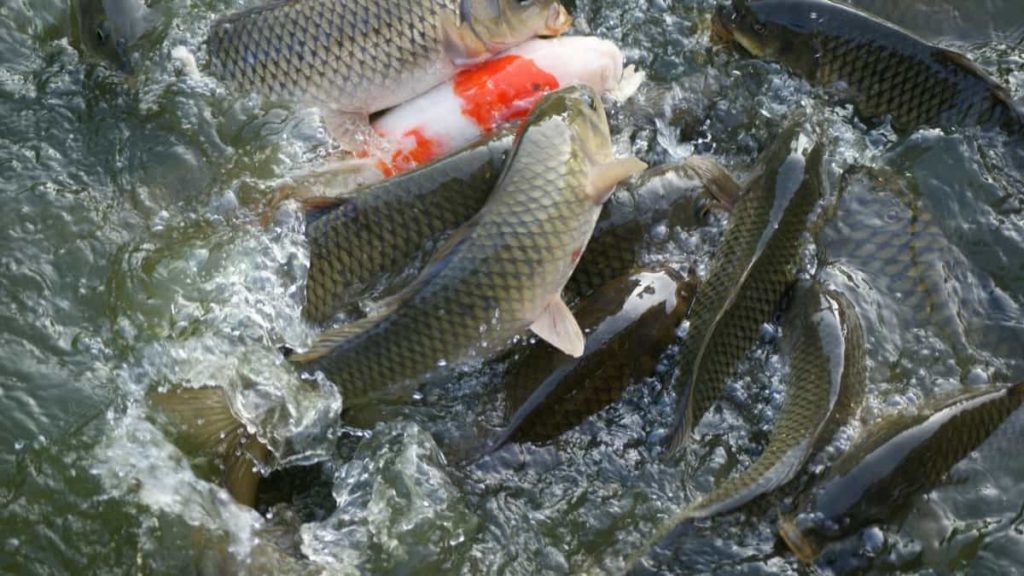
How big should a fish pond be?
- Fish ponds should be 1/2 acre or more in surface area of water.
- Reducing the shallow edges around your deep-water pool will reduce emergent vegetation, most species growing in water less than four feet deep.
- For this reason, create a steep slope to a depth of four feet or more.
What diseases can pond fish get?
Symptoms of Bacterial Infection: The most common bacterial infections in pond fish are ulcers, fin rot, tail rot, mouth rot, and dropsy. Although stress sometimes kills the fish itself, it often reduces its natural ability to fight bacteria and viruses in the water. Symptoms of the fish disease include loss of appetite, abnormal swimming or erratic movements, sores, spots or growths on the body, and discoloration of the fins or body. Keeping your pond clean, well-ventilated, and properly stocked helps prevent common causes of pond fish death.
Can a fish pond be too deep?
- For fish production, too shallow can sometimes be a good thing.
- Too deep, on the other hand, will be unusable for fish.
- These deep areas, anything over eight feet, generally have low oxygen levels, they’re not a good place for bedding, so it’s kind of like the dead zone of a pond.
Which fish is best for ponds?
| Goldfish | Sunfish |
| Golden Tench | Minnows |
| Koi carps | Carp |
| Rosette | Channel Catfish |
| Shubunkin | Tilapia |
| Sturgeon | Trout |
| Golden orfes |
Do I need gravel in my fish pond?
- Pond pebbles not only keep your water clean but they create a natural-looking bottom layer and help provide a safe habitat for your fish.
- One thing to remember is that pebbles will only benefit small garden ponds, as large muddy ponds can swallow these pebbles.
How do you treat an infected fish pond?
- Make sure you have a proper diagnosis of the problem
- Remove absorbent filter material – carbon, zeolite, etc
- Increase aeration
- Allow plenty of time to observe the fish
- Do not mix medications
How do you know if your pond fish are sick?
Changes in behavior, such as erratic swimming, any upside-down swimming, unusual eating patterns, or isolation from others, may indicate that one of your fish is sick.
In case you missed it: How to Start Perch Fish Farming: Raising in Ponds, and Cages, A Step-By-Step Guide for Beginners
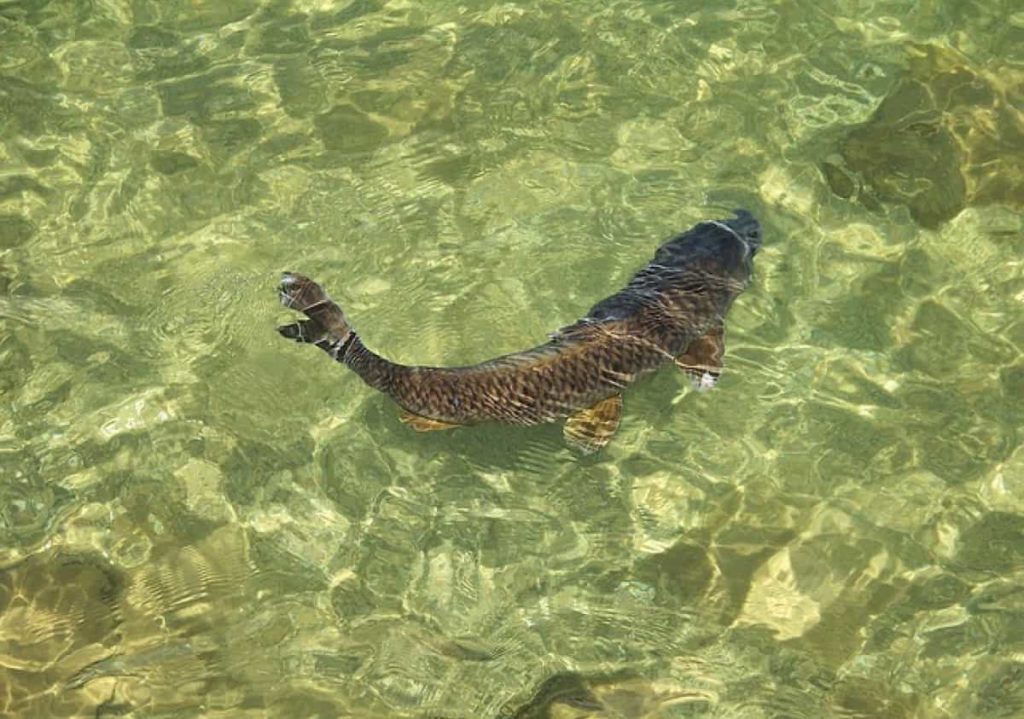
Why is my pond fish suddenly dying?
The main reasons for fish dying are low dissolved oxygen and poor water quality, so purchase a master test kit and test for pH, ammonia, nitrite, and nitrite. The pH should be 7-8, so if the pH is too high (9 or above), that can kill the fish and make the ammonia more toxic. Overcrowding and overfeeding, two common causes of pond fish mortality, create lethal conditions by reducing the amount of available oxygen and increasing waste, increasing ammonia and nitrate levels. Avoid overfeeding by removing leftover food after five minutes.
Oxygen-related fish kills – The most common cause of fish death is suffocation due to lack of dissolved oxygen. Algae and aquatic plants produce the most dissolved oxygen through photosynthesis. When more oxygen is consumed than produced, oxygen levels can drop, leading to fish kills.
Warm water fish need an oxygen level of 5 ppm (parts per million) to maintain good health, and cold water fish need a level of about 6.5 ppm. A sign of oxygen stress is fish gasping for air at the surface, especially early in the morning. Larger fish will die first because they need more oxygen.
Fish die due to pesticide poisoning – Although pesticide-induced fish kills are not as common as those caused by oxygen depletion, some do occur.
Preventing pesticide-related fish kills – When using any pesticide, it is essential to read the label carefully and apply it correctly. To be implemented. Most pesticide labels contain specific language about how the product must be mixed, what equipment to use, and where or when it can be applied. Phrases such as “not applicable to water” or “not applicable to areas adjacent to any body of water” provide clear guidance for determining how and when a pesticide should be used.
A violation has occurred. Be careful when spraying herbicides or other pesticides near ponds, as many are highly toxic to fish. Even herbicides registered for use in ponds, such as algaecides, can be toxic to fish, so it’s important to read labels carefully to determine the product’s toxicity to non-target organisms.
Do fish ponds need to be fenced?
No federal law requires fencing around a pool, but your city may have its jurisdiction, so be sure to ask when you’re installing your pool. Fencing is not only a good method to keep your kids safe but also a good way to keep your fish and other creatures safe from predators.
Where is the best place to put a fish pond?
Find a sunny location for your pond to attract the greatest variety of wildlife. It is best to dig your pond away from trees and shrubs, so the leaves do not swamp the water. Deciding to install a pond in your backyard is a great decision, adding beauty and tranquility to any area, providing interest to fish and plants, and helping your area’s native birds, frogs, and insects. Fencing is an excellent way to keep your kids safe and your fish and other creatures safe from predators.
A pond fence will keep raccoons and other four-legged animals out of your pond. Not to mention your dog who wants to try drinking water or your cat who is interested in eating one of your fish. Ponds are one of the best ways to bring the beauty of nature into your garden, but you need to keep in mind the possibility of needing the fencing. It is easy to do when you install your pond. Ask your pool maintenance person for a referral.
Is rainwater good for fish ponds?
Rainfall can be beneficial by providing your pool with a supply of free, soft water that does not contain chemicals such as chlorine or chloramine. This “free” resource often does not contain harmful chemicals but presents many risks to your pond.
How many fish species do you need to stock a pond?
A typical pond stocking strategy for a warm water pond would be 1,000-1,500 bluegills, 50-100 bass, and 50-200 catfish per acre. However, many recreational pond owners prefer to stock bluegills and catfish to increase bass size and population. When determining the amount of fish in your pond, consider these factors:
- Total pond surface area
- Pond volume
- Size and type of filtration system
- Flow rate
- Temperature
- Climate
If you want more fish, you can add filtration and aeration so the pond can support them.
How do you keep the fish healthy in a pond?
- You will need to aerate your pond
- Remove all debris and dead plants from your pond regularly, even if that means cleaning the pond manually with a pond rake
- Check your pool’s pH level regularly
In case you missed it: Basic Equipment and Tools Required for Fish Farming: A Beginners Guide
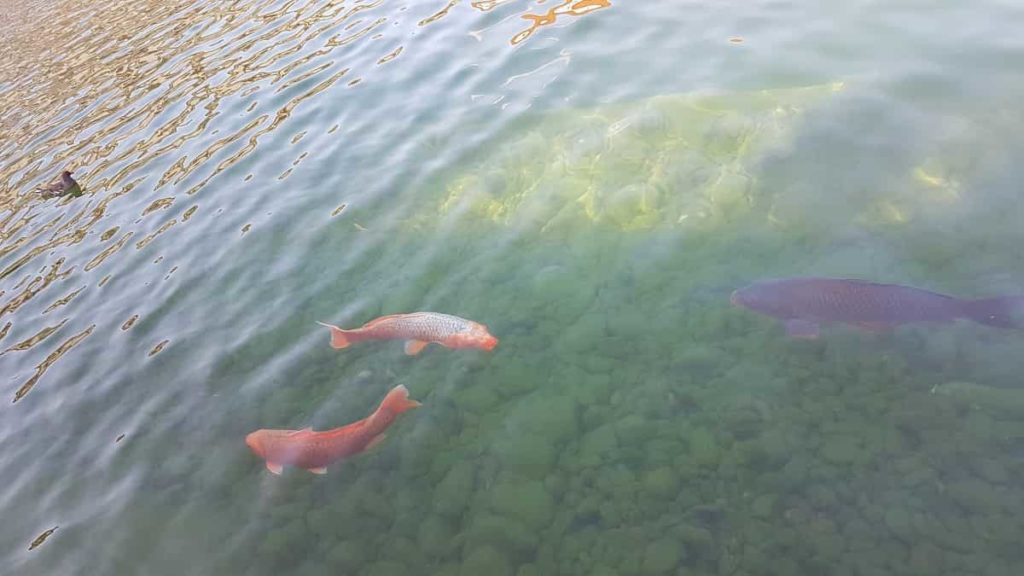
Important health management measures;
Understanding and managing the drainable pond environment is key to successful fish health management and profitable fish culture, and ensuring disease outbreaks are avoided. It is important to know the role of various environmental components. The main thrust of such measures is to:
- Reduce pressure on cultured fish;
- The introduction of serious disease agents prevention;
- Containment of disease spread to affected areas;
- Reducing losses from disease outbreaks.
Key measures are key components of successful fish health management
Monitoring and maintenance of water quality: Sudden and wide fluctuations in some environmental parameters such as dissolved oxygen content, pH, turbidity, temperature, some chemicals, detergents, pesticides, and addition of naturally occurring toxins like hydrogen sulphide, ammonia, ammonia, toxins, etc., often cause stress in fish and make them susceptible to infectious diseases.
Adequate feed – In addition to the natural fish feed available through fertilization, sufficient amounts of good quality supplementary feed are necessary to maintain healthy fish growth. Any food quantity and quality deficiency can cause various diseases by increasing susceptibility to infections.
Removal of dead fish: Dead and visibly diseased fish should be removed. It is important to keep a daily account of losses. Such records will provide valuable insight into problems and may lead to their resolution.
Conclusion
Fish ponds can be a great addition to your backyard. They provide a tranquil environment filled with beautiful plants, fish, and other aquatic life. When planning and building a fish pond, you can customize its design. Your pool will fit in perfectly with the rest of your landscape. It includes site selection, plant and fish selection, and maintenance considerations. This guide outlines the planning process for a fish pond.
- Economical Aquaculture: A Guide to Low-Budget Fish Farming
- 15 Common Planting Errors That Can Doom Your Fruit Trees
- How to Make Houseplants Bushy: Effective Tips and Ideas
- Innovative Strategies for Boosting Coconut Pollination and Yield
- Pollination Strategies for Maximum Pumpkin Yield
- The Complete Guide to Chicken Fattening: Strategies for Maximum Growth
- Natural Solutions for Tulip Problems: 100% Effective Remedies for Leaf and Bulb-Related Issues
- Revolutionizing Citrus Preservation: Towards a Healthier, Greener Future
- Natural Solutions for Peony Leaf and Flower Problems: 100% Effective Remedies
- Maximizing Profits with Avocado Contract Farming in India: A Comprehensive Guide
- Natural Solutions for Hydrangea Problems: 100% Effective Remedies for Leaf and Flowers
- The Ultimate Guide to Choosing the Perfect Foliage Friend: Bringing Life Indoors
- From Sunlight to Sustainability: 15 Ways to Use Solar Technology in Agriculture
- The Ultimate Guide to Dong Tao Chicken: Exploring from History to Raising
- The Eco-Friendly Makeover: How to Convert Your Unused Swimming Pool into a Fish Pond
- Mastering the Art of Delaware Chicken Farming: Essentials for Healthy Backyard Flocks
- 20 Best Homemade Fertilizers for Money Plant: DIY Recipes and Application Methods
- How to Craft a Comprehensive Free-Range Chicken Farming Business Plan
- Brighten Your Flock: Raising Easter Egger Chickens for Beauty and Bounty
- How to Optimize Your Poultry Egg Farm Business Plan with These Strategies
- Subsidy for Spirulina Cultivation: How Indian Government Schemes Encouraging Spirulina Farmers
- Ultimate Guide to Raising Dominique Chickens: Breeding, Feeding, Egg-Production, and Care
- Mastering the Art of Raising Jersey Giant Chickens: Care, Feeding, and More
- Ultimate Guide to Raising Legbar Chickens: Breeding, Farming Practices, Diet, Egg-Production
- How to Raise Welsummer Chickens: A Comprehensive Guide for Beginners
- How to Protect Indoor Plants in Winter: A Comprehensive Guide
- Ultimate Guide to Grow Bag Gardening: Tips, Tricks, and Planting Ideas for Urban Gardeners
- Guide to Lotus Cultivation: How to Propagate, Plant, Grow, Care, Cost, and Profit
- Agriculture Drone Subsidy Scheme: Government Kisan Subsidy, License, and How to Apply Online
- Ultimate Guide to Raising Araucana Chickens: Breed Profile, Farming Economics, Diet, and Care
- Bringing Hydroponics to Classroom: Importance, Benefits of Learning for School Students
- Ultimate Guide to Raising Polish Chickens: Breed Profile, Farming Economics, Diet, and Care
- Ultimate Guide to Raising Australorp Chickens: Profile, Farming Economics, Egg Production, Diet, and Care
- Silkie Chicken Farming: Raising Practices, Varieties, Egg Production, Diet, and Care
- Sussex Chicken Farming: Raising Practices, Varieties, Egg Production, Diet and Care